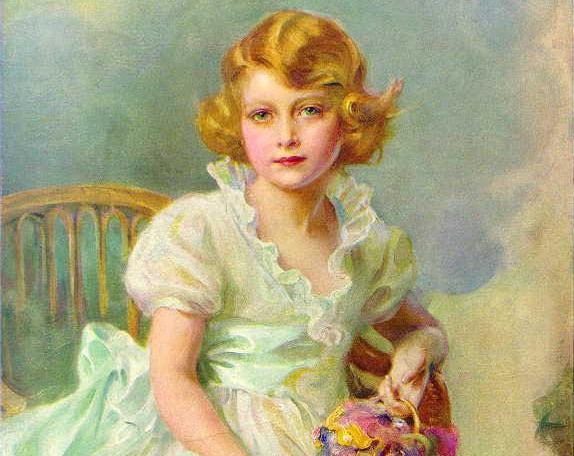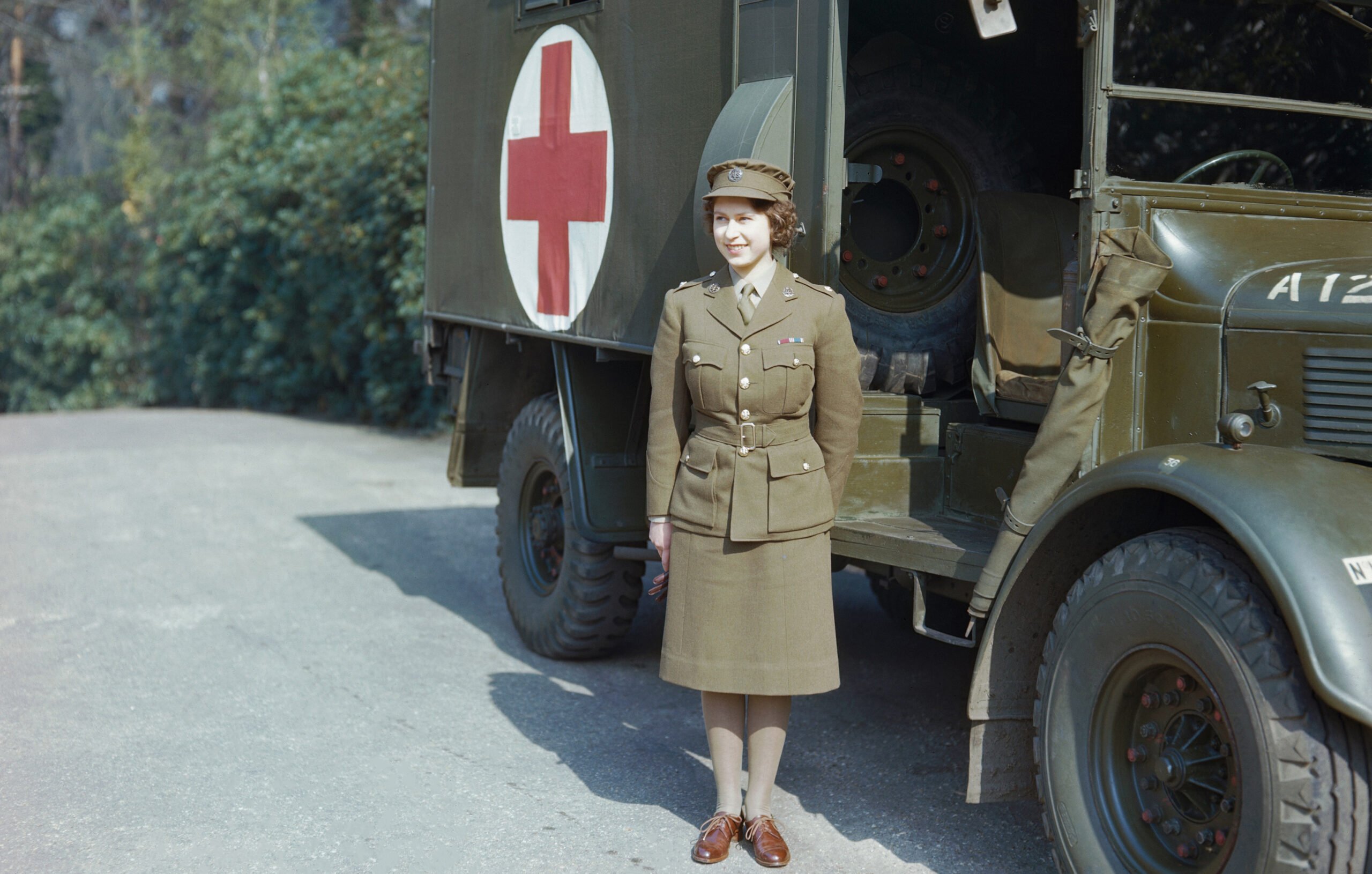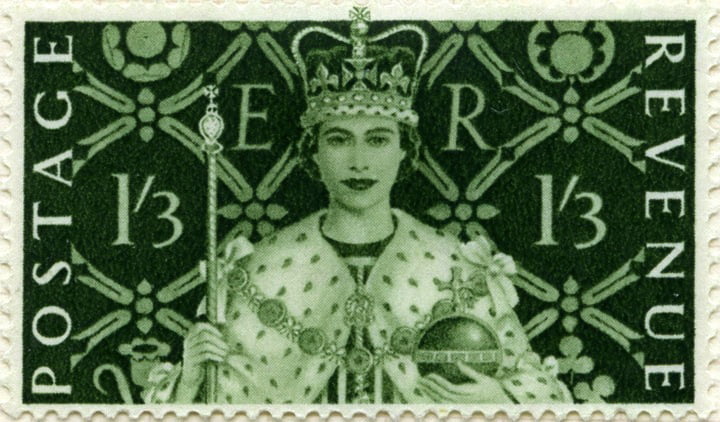
The arrival of Margaret Rose led to the appointment of Marion Crawford (‘Crawfie’) as governess to the two young princesses. They followed a schoolroom timetable that would have been recognisable to young ladies of the 19th century: arithmetic, grammar, writing, history, geography. Other ladylike accomplishments included music, art and dancing. In addition the girls were taught French conversation by Madame Montaudon-Smith.
In 1931 King George V gave the family a country estate of their own, the Royal Lodge in Windsor Great Park. This secluded residence was set in substantial gardens, which were enthusiastically tended by the Duke of York. The family enjoyed weekends down at the Lodge, and Elizabeth was given riding lessons by the groom there. In 1932 the people of Wales had presented Elizabeth with a miniature cottage, fully equipped with gadgets and household essentials, and the two princesses enjoyed playing at imaginary housewives.
They spent Easter with the King and Queen at Windsor Castle, Christmas and New Year at Sandringham, and in August and September they went up to Scotland to spend time with their maternal grandparents.
The young princesses spent a great deal of their time in adult company, and were very close to both their parents. They had very little contact with other children and were fascinated by them. Crawfie attempted to take them on forays into the outside world, to a museum or art gallery, but they were always recognised and the expeditions were curtailed. They did, however, socialise to a limited extent with children from court circles, and there were frequent children’s parties.
While Elizabeth enjoyed playing with her irascible grandfather George V, both sisters were intimidated and awed by their majestic grandmother, Queen Mary. Swathed in fox furs and jewel-bedecked, Queen Mary was profoundly aware of her obligations as a monarch, and a fount of knowledge about the royal family. She inculcated the young Elizabeth with a sense of duty and an awareness of the dignity of the monarchy.
The King began to train his eldest daughter for the day when she would inevitably become Queen. Her schoolroom education syllabus was expanded to include Latin, constitutional history and law, and she was taught by her father and Henry Marten, the Vice-Provost of Eton. She was also instructed in religion by the Archbishop of Canterbury. She was encouraged to take an interest in politics and current affairs, and a visiting ambassador observed, “The King would also talk to his elder daughter more seriously than most fathers do to so young a child. It was as if he spoke to an equal...”
Elizabeth’s future was always in her parents’ minds. When important politicians and statesmen joined the King and Queen for lunch, she was summoned to attend, and was encouraged to make conversation with their illustrious guests.

When war broke out, the royal family was at Balmoral, and the princesses remained there for the first few months of the war. Here, they carried on their usual round of lessons but also participated in weekly sewing parties for war work, which were attended by the local crofters’ wives and palace employees. They joined their parents in Sandringham, as usual, for Christmas, and then were sent to the Windsor.
At Windsor the teenage Elizabeth lived in the nursery quarters in Augusta Tower, and followed a strict, and timeless, routine: lessons in the morning, a ride in the park before lunch, more lessons in the afternoon, tea, free time (often spent with the Girl Guides), supper and bed. Henry Marten drove up regularly from Eton in a book-laden dogcart to carry on Elizabeth’s education in English history. In 1942 Mme Antoinette de Bellaigue, a Belgian aristocrat who escaped occupied Europe, joined the household, and taught the princesses French conversation and continental history.
Wartime Windsor was austere: chandeliers were taken down, priceless art removed from the walls, the grand state apartments were swathed in dust sheets. Fuel rationing, from 1941, put an end to central heating, and the imposing rooms were heated by coal fires. Hot water was severely rationed. Following the nationwide appeal to ‘Dig for Victory’, the ornamental gardens were ploughed up and given over to vegetable cultivation. A herd of pigs, fattened on the scraps from the Castle kitchens, supplemented the otherwise monotonous diet.
The Princesses collected tinfoil, rolled bandages and knitted socks for the forces. They contributed pocket money to various charities engaged in war work. A number of charity galas were also staged at Windsor. At one of these galas Elizabeth appeared as a solo artiste, dancing a French minuet to the accompaniment of a violin.
A Company of Grenadier Guards was stationed at Windsor Castle for the duration of the war to guard the royal family. Young officers were invited to lunch at the Castle with the princesses and their governesses, and there were picnics, dances, and games of after-dinner charades.
In 1942, on her 16th birthday, Elizabeth was created a Colonel of the Grenadier Guards, and on the morning of her birthday she inspected the regiment on parade for the very first time. She was also registered at the local Labour Exchange under the wartime youth service scheme. But this proved to be a symbolic gesture; the King was unwilling to let his daughter venture beyond the Castle walls. At 18 she was appointed a Counsellor of State – certain powers could be delegated to her when the King was absent or abroad. But she still felt frustrated: “I ought to do as other girls do.”
Finally, in the spring of 1945, Elizabeth was allowed to join the Auxiliary Territorial Service (ATS) as Second Subaltern Elizabeth Alexandra Mary Windsor. She had already been taught to drive in the grounds of Windsor Castle, and on 23 March she embarked on a Cadre Course at Camberley in Surrey. Over the three-week course she mixed, to a limited extent, with ordinary young women, and was given a crash course in car mechanics and map-reading. In July 1945 she was promoted to the rank of Junior Commander. On VE Day, 7 May 1945, she and her sister slipped out, incognito, amongst celebrating London crowds: “I remember lines of unknown people linking arms and walking down Whitehall, all of us just swept along on a tide of happiness and relief.”

Philip had seen active service in the Royal Navy during the war, and when he was on home leave he was a frequent visitor at Windsor Castle, where the romance blossomed. At the end of the war Philip was on duty in the Far East, and did not return to England until March 1946. But Elizabeth’s feelings were unchanged; when he proposed to her at Balmoral in late summer 1946 she accepted.
The King was taken aback by his eldest daughter’s determination to marry, and asked her to promise that nothing would be made official until her 21st birthday. In the meantime, the family was committed to an official tour of South Africa, which took place in February 1947. Throughout the tour Princess Elizabeth stayed in constant touch with her fiancé, who had become a naturalised British subject, and was now known as Lieutenant Philip Mountbatten. The King could hold out no longer, and on 10 July 1947, “with greatest pleasure”, the engagement was announced. That evening the Princess and her fiancé made an impromptu balcony appearance in front of cheering crowds, who relished the prospect of a royal wedding.
The notion of a post-war Renaissance, symbolised by Elizabeth's marriage, was consciously echoed by the designer, Norman Hartnell, who created an exquisite wedding dress inspired by Botticelli’s Primavera. The white satin gown was garlanded with York roses, star flowers and orange blossom, all encrusted with pearls and crystals.
Accompanied by eight bridesmaids and two pageboys, Elizabeth was greeted by a fanfare, and began her long walk down the nave to the sound of the choir singing ‘Praise my Soul, the King of Heaven’. At the altar stood the groom dressed in his ordinary naval uniform, but wearing the insignia of a Knight Companion of the Order of the Garter. Just that morning the King had given him the title of Duke of Edinburgh. The Archbishop of York, who gave the address, told the couple: “Notwithstanding the splendour and national significance of the service in this Abbey, it is in all essentials the same as it would be for any cottager who might be married this afternoon in some small country church.”
Despite the austerity of post-war Britain, Princess Elizabeth’s wedding was marked by a wave of public enthusiasm, both at home and abroad. The young couple were showered with gifts, and when the news came out that the Princess would have to collect clothing coupons for her dress, she was inundated with gifts of coupons (which had to be returned).
The couple’s wedding cake, nine feet high and constructed of four tiers, was created with the intention of reaching out to the Commonwealth, and as such used ingredients from around the world, including some given by the Australian Girl Guides. After the wedding, slices of cake were distributed all over the country.

On her accession, Elizabeth had dedicated herself to service of the Commonwealth. Her embroidered white satin gown, designed by Norman Hartnell, used subtle shades of pink, blue, yellow and green to incorporate the emblems of Britain and the Commonwealth into the design: the Tudor rose, the thistle, leek, shamrock, the Canadian maple leaf, the Australian wattle flower, the fern of New Zealand, the protea of South Africa, the wheat and jute of Pakistan and the lotus of Ceylon. Made of Lullingstone silk, it was worked by six embroideresses in the utmost secrecy.
Before the coronation, the Queen practised for hours wearing the 5-lb St. Edward’s Crown. On her way to the Abbey she wore the ermine-edged Robe of State of Crimson Velvet. On her return she wore the Imperial Robe of Purple Velvet, lined with white silk and ermine-edged. Both robes, made by Ede and Ravenscroft, were cut on narrower than traditional lines to reduce the weight and display the magnificent gown.
Despite drizzly weather, the streets of London were crowded with millions of onlookers, who gazed at the stately procession of royalty, peers, ambassadors, diplomats and dignitaries, who arrived at Westminster Abbey in an array of cars and carriages.
The guests began taking their seats from 7am. At 11.20am the Queen arrived at the Abbey in the state coach, and was greeted by the Duke of Norfolk, Earl Marshal. She was accompanied by Prince Philip, resplendent in the uniform of an Admiral of the Fleet, with gold bullion epaulettes and Garter Star.
The ensuing ceremony was a piece of theatre that had been six months in the making. The Abbey had been closed since January so that tiered seating could be built for the 8,251 guests. Acres of blue and gold carpet had been woven in Glasgow. In Bradford 4,000 yards of velvet had been woven to cover 2,000 chairs and 5,700 stools. The 60-strong orchestra and 400-strong choir had rehearsed relentlessly.
The Queen walked down the aisle to the strains of Parry’s ‘I was Glad’, and shouts of ‘Vivat Regina’. The ensuing ceremony has remained fundamentally unchanged over the last thousand years; the first English monarch to be crowned in the Abbey was William the Conqueror in 1066. It is steeped in symbolism, pageantry and a religious sense of awe. It brings together not only the monarch, but the greatest religous leaders in the realm and the scions of the nobility.
The core of the ceremony, performed by the Archbishop of Canterbury, was the recognition of the sovereign by the assembled congregation, the administration of the Coronation Oath, the anointing with holy oil (the secret recipe contains oils of orange flowers, roses, jasmine, cinnamon, musk, civet and ambergris), the investiture with the royal regalia and the actual crowning. These key moments in the historic service were punctuated with trumpet fanfares and shouts of ‘God save the Queen’, and the robing in ritual garments – a simple white over-dress, the golden supertunic and the Dalmatic Robe. The St. Edward’s Crown, made for the coronation of Charles II, was placed on the Queen’s head at 12.34pm, and the acclamation of the congregation was matched by the firing of canon salutes from the Tower of London. Elizabeth exited the Abbey at 2.53pm, wearing the Imperial State Crown.
For the first time, the recognition, crowning and homage were televised, but the most sacred parts of the ceremony – the anointing and communion – would remain private. In the event over 20 million people watched the BBC coverage of the coronation, and many more watched worldwide.
Britain was still plunged in post-war austerity, and the coronation was the excuse for a nationwide party. Although rationing was still in force, Churchill insisted that an extra 1lb of sugar should be made available to everybody. Rationing restrictions were lifted from eggs and sweets. Even applications to roast a whole ox, a traditional coronation celebration, were allowed under certain circumstances. The Government spent over £2 million on celebrations.

Looks like you haven't made a choice yet.